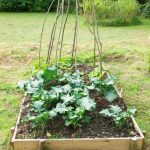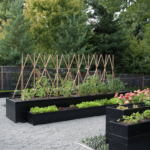High tunnel vegetable gardening has gained popularity in recent years as a sustainable and efficient method for growing a variety of crops. In this article, we will explore the many benefits and advantages of high tunnel gardening, including its ability to extend the growing season, protect plants from harsh weather conditions, and provide a controlled environment for optimal growth.
Whether you are a seasoned gardener or new to the world of vegetable cultivation, high tunnel gardening offers an array of opportunities for successful harvests.
One of the key factors in successful high tunnel vegetable gardening is choosing the right location for your structure. Factors such as sunlight exposure, wind protection, and proximity to water sources all play a crucial role in the productivity of your garden. In addition to location, selecting the best vegetables for high tunnel gardening is essential. We will provide recommendations for crops that thrive in this environment and yield bountiful harvests.
Furthermore, we will delve into the process of building and setting up your high tunnel, offering a step-by-step guide and outlining the essential tools needed for a successful endeavor. Once established, maintaining ideal growing conditions inside your high tunnel is vital for plant health and productivity.
Tips for temperature control, watering practices, and pest management will be discussed to ensure optimal growth throughout the season. Whether you are new to high tunnel vegetable gardening or looking to expand your knowledge, this article will provide valuable insights into maximizing production and yield while troubleshooting common issues that may arise along the way.
Choosing the Right Location for Your High Tunnel
When it comes to high tunnel vegetable gardening, one of the most crucial decisions you’ll make is choosing the right location for your structure. The success of your crops will largely depend on the environmental conditions where your high tunnel is situated. There are several factors to consider when selecting the best location for your high tunnel, as well as some best practices to follow in order to maximize the potential of your vegetable garden.
Factors to Consider
The first factor to consider when choosing a location for your high tunnel is sunlight. Positioning your structure in an area that receives ample sunlight throughout the day is essential for the growth and development of your vegetables. Additionally, considering wind patterns and potential windbreaks is important in order to protect your crops from damage.
Another important consideration is the quality of the soil in the chosen location. Conducting a soil test can provide valuable information about its composition and suitability for growing vegetables. Proper drainage is also crucial, as excess water retention can lead to root rot and other issues.
Best Practices
One best practice for choosing a location for your high tunnel is to ensure that it is easily accessible for maintenance and harvesting. This will make tending to your crops much more efficient and convenient. It’s also recommended to orient your high tunnel in a north-south direction to optimize sun exposure and minimize shadow casting.
In addition, consulting with local agricultural extension services or experienced growers in your area can provide valuable insights into which locations have historically been successful for high tunnel vegetable gardening. By taking these factors and practices into consideration, you can set yourself up for a successful and productive growing season inside your high tunnel structure.
Selecting the Best Vegetables for High Tunnel Gardening
When it comes to high tunnel vegetable gardening, selecting the right vegetables is crucial for a successful and bountiful harvest. The controlled environment of a high tunnel allows for extended growing seasons and protection from harsh weather conditions, making it ideal for a wide variety of vegetables. Here are some recommendations for the best vegetables to grow in your high tunnel:
- Tomatoes: Tomatoes thrive in the warm and sheltered environment of a high tunnel. With proper care and maintenance, you can expect a hearty crop of delicious tomatoes throughout the growing season.
- Cucumbers: Cucumbers require plenty of warmth and sunlight, making them well-suited for high tunnel gardening. With the added protection from pests and diseases, cucumbers can flourish inside a high tunnel.
- Peppers: Whether it’s bell peppers, hot peppers, or sweet peppers, these heat-loving vegetables are perfect for high tunnels. You can expect higher yields and healthier plants when grown inside this controlled environment.
In addition to these recommendations, other popular vegetables for high tunnel gardening include lettuce, spinach, carrots, and radishes. These cool-weather crops benefit from the protection provided by a high tunnel and can be grown earlier in the spring or later in the fall than in traditional outdoor gardens.
Furthermore, it is important to consider the space available inside your high tunnel and plan accordingly when selecting which vegetables to grow. Some crops may require more vertical space or spread out more than others, so it is essential to take this into account when planning your high tunnel vegetable garden.
By choosing the right mix of vegetables that thrive in a protected environment, you can maximize your harvests and enjoy an abundance of fresh produce throughout the year through high tunnel vegetable gardening.
Building and Setting Up Your High Tunnel
Building and setting up a high tunnel for vegetable gardening can be an exciting endeavor, but it requires careful planning and execution. With the right approach, you can create an optimal environment for your plants to thrive and produce bountiful harvests.
Step-by-Step Guide
The first step in building your high tunnel is to carefully measure and mark the location where it will be erected. Once you have determined the size and orientation of your high tunnel, you can begin assembling the frame. This typically involves connecting the metal or PVC pipes to form the structure of the tunnel.
Next, you will need to cover the frame with greenhouse plastic to create a protective barrier from external elements. It’s important to ensure that the plastic is securely attached to the frame to prevent any potential damage from wind or inclement weather.
Essential Tools Needed
When building and setting up your high tunnel, there are several essential tools that you will need to have on hand. These may include a hammer, drill, screwdriver, measuring tape, and sturdy ladders for reaching elevated areas. Additionally, having a staple gun or wiggle wire system will be crucial for securing the greenhouse plastic to the frame.
It is also important to consider ventilation when setting up your high tunnel. You may need exhaust fans or sidewall vents depending on the size of your structure. Proper ventilation is essential for maintaining optimal growing conditions inside the high tunnel and preventing issues such as excessive humidity or heat buildup.
By following these steps and using the right tools, you can effectively build and set up your high tunnel for successful vegetable gardening. With proper construction and attention to detail, you can create an ideal environment for your plants to flourish within their protected space.
Maintaining the Ideal Growing Conditions Inside Your High Tunnel
In addition to temperature, proper watering is essential for high tunnel vegetable gardening. Since high tunnels offer protection from rain, you will need to manually water your plants.
Drip irrigation systems are a popular choice for high tunnel gardening as they deliver water directly to the roots, reducing water waste and minimizing the risk of diseases caused by moisture on plant foliage. Regularly monitoring soil moisture levels and adjusting your watering schedule accordingly is key to ensuring healthy plant growth inside your high tunnel.
Pest control is another important aspect of maintaining ideal growing conditions in a high tunnel. While the cover of a high tunnel provides some protection from pests, it’s still important to implement pest management strategies to prevent infestations that can damage your crops.
This may include using physical barriers like screens or row covers, practicing crop rotation, integrating beneficial insects for natural pest control, and applying organic pesticides when necessary. By staying proactive with pest management, you can protect your high tunnel vegetables from common pests and diseases without relying on harmful chemical interventions.
Extending the Growing Season With High Tunnel Gardening
High tunnel vegetable gardening offers the advantage of extending the growing season, allowing gardeners to produce fresh vegetables for a longer period. By creating a controlled environment, high tunnels provide protection from harsh weather conditions and temperature fluctuations, thereby maximizing production and yield. Here are some tips for extending the growing season with high tunnel gardening:
- Utilize season-extending techniques: High tunnels allow for the use of season-extending techniques such as row covers, cloches, and frost blankets. These tools can provide additional protection to plants during colder months or unexpected temperature drops.
- Implement succession planting: Take advantage of the extended growing season by practicing succession planting in your high tunnel. This involves planting crops at different times to ensure a continuous supply of vegetables throughout the growing season.
- Explore heat-loving crops: In a high tunnel environment, it’s possible to grow heat-loving crops that may not thrive in outdoor conditions. Consider planting vegetables such as tomatoes, peppers, eggplants, and cucumbers to maximize production during warmer months.
By implementing these strategies, gardeners can make the most out of their high tunnel vegetable gardening efforts, resulting in an increased production and yield of fresh, homegrown vegetables throughout an extended growing season.
Remember also to regularly inspect your plants for signs of pest infestations or diseases that can impact production. By being proactive and addressing issues promptly, you can maintain optimal growing conditions inside your high tunnel and extend your harvest well into late fall or early winter.
Through proper planning and the utilization of available resources within a high tunnel environment, gardeners can continue to enjoy a bountiful harvest long after traditional outdoor gardens have ceased producing. High tunnel vegetable gardening provides an opportunity for sustainable agriculture practices by maximizing productivity on a smaller footprint of land while also reducing environmental impact.
As more gardeners and farmers adopt this method, it is clear that the future of vegetable gardening lies in utilizing innovative solutions like high tunnels to ensure food security and sustainability.
Harvesting and Caring for Your High Tunnel Vegetables
When it comes to high tunnel vegetable gardening, harvesting and caring for your crops are crucial steps in ensuring a bountiful yield. One of the key advantages of high tunnel gardening is the ability to protect your vegetables from harsh weather conditions, pests, and diseases, allowing for a longer growing season and better quality produce. To make the most of your high tunnel garden, proper harvesting techniques and ongoing care are essential.
Harvesting your high tunnel vegetables at the right time is important to ensure optimal flavor and nutrition. Different vegetables have specific signs that indicate they are ready for harvest, such as color, size, or texture. It’s important to regularly inspect your plants to determine the ideal time for picking. Additionally, proper care after harvesting is also crucial. This includes handling the vegetables with care to avoid damage, cleaning them properly, and storing them in appropriate conditions to maintain freshness.
In terms of ongoing care for your high tunnel vegetables, it’s essential to monitor the growing conditions inside the tunnel. This involves regulating temperature and humidity levels, as well as providing adequate watering and nutrition for the plants. Regular pest control measures should also be implemented to prevent infestations that could damage your crops. By consistently tending to your high tunnel garden, you can ensure healthy plant growth and a plentiful harvest throughout the growing season.
| High Tunnel Vegetable Gardening | Harvesting & Caring |
|---|---|
| Benefits of protecting crops from harsh weather & pests | Importance of proper harvesting techniques & ongoing care |
| Promotes longer growing seasons & higher quality produce | Frequent inspection of plants to determine ideal harvest time |
| Regulating temperature & humidity levels inside the tunnel | Adequate watering & pest control measures for ongoing care |
Troubleshooting Common Issues in High Tunnel Vegetable Gardening
One of the key aspects of successful high tunnel vegetable gardening is being able to troubleshoot and address common issues that may arise. While high tunnels offer many benefits, such as extended growing seasons and protection from the elements, they also present their own set of challenges. It’s important for gardeners to be aware of these challenges and equipped with the knowledge to effectively address them.
One common issue that gardeners may encounter in high tunnel vegetable gardening is maintaining the ideal temperature inside the structure. High tunnels can become too hot during the day, especially in the summer months, which can be detrimental to certain vegetable crops. It’s important to implement strategies such as proper ventilation, shade cloth, and strategic planting to help regulate the temperature inside the high tunnel.
Another challenge that gardeners may face is controlling pests and diseases within the high tunnel environment. Because high tunnels create a sheltered and humid environment, they can sometimes become breeding grounds for pests and diseases. Implementing integrated pest management strategies, such as regular inspections, crop rotation, and using organic pest control methods, can help mitigate these issues.
Additionally, managing water and irrigation within a high tunnel setting can also pose challenges. The enclosed environment of a high tunnel affects moisture levels, so it’s important for gardeners to monitor soil moisture regularly and adjust watering practices accordingly. Proper drainage systems and irrigation methods are also essential in preventing waterlogged soil and potential root rot issues.
By understanding these common challenges in high tunnel vegetable gardening and knowing how to effectively troubleshoot them, gardeners can maximize their chances of a successful harvest. With careful attention to detail and proactive problem-solving, it’s possible to overcome these hurdles and enjoy bountiful yields from a high tunnel vegetable garden.
Conclusion
In conclusion, high tunnel vegetable gardening offers numerous benefits and advantages for growers, including extended growing seasons, protection from extreme weather, and increased control over growing conditions. As more farmers and gardeners recognize the potential of high tunnel gardening, it is becoming increasingly popular as a sustainable agricultural practice. The ability to produce high-quality vegetables year-round can contribute to food security and reduce our reliance on imported produce.
The future of high tunnel vegetable gardening looks promising as technology continues to advance, making it easier to maintain ideal growing conditions inside the tunnels. With the right location, proper selection of vegetables, and careful maintenance, growers can maximize their production and yield even in challenging climates. Additionally, as more research is conducted on advanced techniques for pest control and environmental sustainability within high tunnels, we can expect even greater efficiency and productivity in the coming years.
As awareness of the benefits of high tunnel vegetable gardening grows, there is potential for this practice to play a significant role in sustainable agriculture. By providing a reliable source of fresh produce throughout the year and reducing the carbon footprint associated with long-distance transportation of fruits and vegetables, high tunnel gardening has the opportunity to positively impact local food systems and promote environmental stewardship.
With ongoing innovation and education in this field, we can look forward to an even brighter future for high tunnel vegetable gardening.

If you’re looking to get into vegetable gardening, or are just looking for some tips on how to make your current garden better, then you’ve come to the right place! My name is Ethel and I have been gardening for years. In this blog, I’m going to share with you some of my best tips on how to create a successful vegetable garden.





